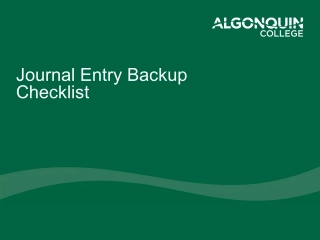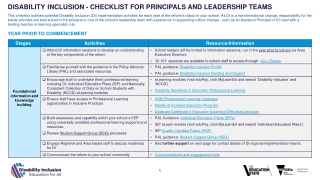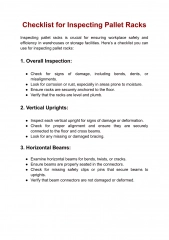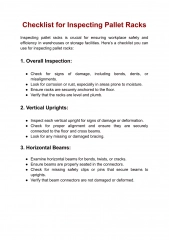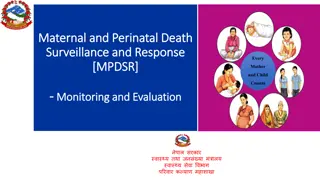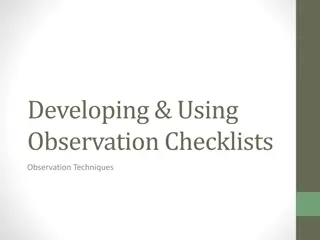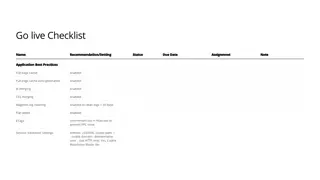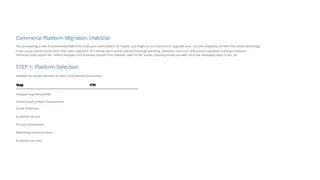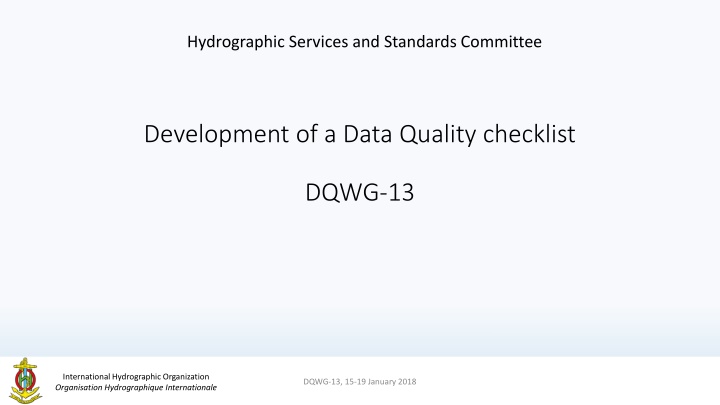
Data Quality Checklist Development for Hydrographic Services and Standards
Explore the importance of a Data Quality (DQ) Checklist in ensuring interoperability and accuracy of hydrographic data. The checklist aids in addressing data quality aspects harmoniously, from user requirements to final reported data quality. Quality assurance procedures are crucial throughout the data production process to maintain metadata integrity.
Download Presentation

Please find below an Image/Link to download the presentation.
The content on the website is provided AS IS for your information and personal use only. It may not be sold, licensed, or shared on other websites without obtaining consent from the author. If you encounter any issues during the download, it is possible that the publisher has removed the file from their server.
You are allowed to download the files provided on this website for personal or commercial use, subject to the condition that they are used lawfully. All files are the property of their respective owners.
The content on the website is provided AS IS for your information and personal use only. It may not be sold, licensed, or shared on other websites without obtaining consent from the author.
E N D
Presentation Transcript
Hydrographic Services and Standards Committee Development of a Data Quality checklist DQWG-13 International Hydrographic Organization Organisation Hydrographique Internationale DQWG-13, 15-19 January 2018
Why a DQ Checklist? Quality requires that rich and meaningful metadata be used Fitness for use requires the involvement of technical arrangements that ensure interoperability A lack of quality that manifests as incompatibility, incomparability and different levels of accuracy of data may jeopardize interoperability Lack of shared terminology for the documentation of Data Quality Original quality and usability + transformation to S1xx data model -> final reported data quality in metadata DQ is intermediate between Data Product Specification and Interoperability Specification (data supplier/user) HSSC requires DQWG to provide advice on data quality aspects to all Working Groups and Project Teams developing S-100 based product specifications Objective: to ensure that the data quality aspects are addressed in an appropriate and harmonized way for all S-100 based product specifications International Hydrographic Organization Organisation Hydrographique Internationale DQWG-13, 15-19 January 2018
Data production specification Classical process of geo-information acquisition is defined by rigorous workflows that can be divided into five distinct phases: 1. Study of user requirements 2. Development of specifications 3. Production 4. Conformance testing 5. Metadata publication Each of these phases should be accompanied by a quality assurance procedure, which documents each step as metadata International Hydrographic Organization Organisation Hydrographique Internationale DQWG-13, 15-19 January 2018
Supplier side of data product The data product specification translates user requirements into data content and technical characteristics. International Hydrographic Organization Organisation Hydrographique Internationale DQWG-13, 15-19 January 2018
User side of data product (SDIs) Over-ambitious interoperability requirements may lead to excessive costs or the impossibility of data sharing. International Hydrographic Organization Organisation Hydrographique Internationale DQWG-13, 15-19 January 2018
Data Quality dilemma in SDIs Interoperability adds the value of coherent representation of spatial data International Hydrographic Organization Organisation Hydrographique Internationale DQWG-13, 15-19 January 2018
Data quality model 1. Definition of the DQ units 2. DQ measures and their parameters 3. A priori DQ result targets 4. Value types of the results 5. Methods for aggregating DQ results 6. Scope of the data quality evaluation procedure 7. Accepted evaluation methodologies Metadata always reports a-posteriori values. Quality at dataseries level, dataset level and spatial object type International Hydrographic Organization Organisation Hydrographique Internationale DQWG-13, 15-19 January 2018
Data quality elements 1. Completeness 2. Logical consistency 3. Positional accuracy 4. Temporal quality 5. Thematic accuracy 6. Aggregation measures 7. Usability The final result is conformity: fully conformant, not conformant or not evaluated. International Hydrographic Organization Organisation Hydrographique Internationale DQWG-13, 15-19 January 2018
Outcome 1. A data quality checklist for other WG/PT 2. Initial check of S-1xx product specifications by DQWG 3. Report to other WG/PT as input for HSSC10 4. Feedback from other WG/PT on DQ checklist 5. Improvement of the DQ checklist 6. Final DQ checklist to be used by WG/PT International Hydrographic Organization Organisation Hydrographique Internationale DQWG-13, 15-19 January 2018

